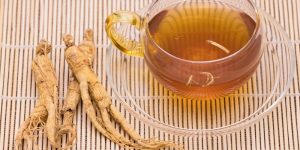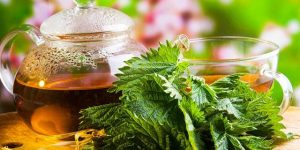
O tulsi tea, comes from an Ayurvedic herb widely used in herbal teas therapeutic and health tea blends, it can be called tulasi, holy basil, “Elixir of Life” or “Queen of Herbs”.
Native to India and grown throughout Southeast Asia, it is considered a foundational herb that, combined with other adaptogenic herbs, can help the body resist many forms of stress and have other benefits.

What is tulsi tea?
The tulsi plant is a member of the mint family closely related to culinary basil. But it is differentiated by its medicinal properties and some physical characteristics.
It has been harvested for use in Ayurvedic treatments for 5,000 years. Therefore, it has a strong aroma and a flavor that can range from peppery to astringent. It is usually combined with black tea leaves.
It is also used with green or white or in an herbal blend with other health-promoting ingredients such as turmeric and ginger. Therefore, this combination can make your tea more beneficial.((https://www.hindawi.com/journals/ecam/2017/9217567/))
Health Benefits of Tulsi Tea:
tulsi tea It has been used for centuries to cure symptoms of various diseases and illnesses. But its power as an adaptogen is better known in modern times.
Some scientific studies have demonstrated its effectiveness as an anti-inflammatory. Treatment of anxiety, although no large-scale formal research has been conducted.
Fights respiratory diseases:
tulsi tea can relieve symptoms of asthma, bronchitis, colds, congestion, cough, flu, sinusitis, sore throat and similar illnesses. To clear your sinuses, inhale the steam from a cup of tea before drinking it.
Reduces blood pressure and reduces stress:
Regular consumption of tulsi can reduce blood pressure and cholesterol. Regulating cortisol levels, reducing the risk of stroke, heart attack and other related diseases.
It can also help relieve headaches and may lessen anxiety and depression for some. Regular consumption can lead to better sleep. Bringing more peace of mind.
Treats gastrointestinal disorders:
tulsi tea can be used to treat indigestion, intestinal parasites, ulcers, vomiting, gastric disorders, and stomach or menstrual cramps. It can also reduce the pain of kidney stones and may help prevent them.
Relieves Arthritis:
O tulsi tea can help reduce inflammation and relieve joint pain associated with arthritis.
Regulates blood sugar:
To drink tulsi tea can help keep blood sugar levels stable. It can also improve metabolism and promote the efficient processing of carbohydrates and fats.
Antiseptic:
Tulsi can kill harmful bacteria in the mouth, resulting in cleaner teeth and fresher breath. It can also relieve acne, slow the effects of aging, and relieve itching or stinging from insect bites.((https://www.elsevier.com/books/natural-standard-herb-and-supplement-guide/unknown/ 978-0-323-07295-3))
Tulsi Tea Uses:
Alternative medicine practitioners use tulsi as a powerful adaptogenic herb (an herb that reduces stress and increases energy). It may also reduce the frequency and severity of asthma attacks.
Function as an anti-inflammatory and promote detoxification. It can modulate the immune system and protect the liver of environmental toxins, cleaning it.
In the United States, the tulsi tea it is most commonly found packaged for use as herbs. In Asia, cooks often add fresh holy basil leaves to stir-fries or soups.
How to drink tulsi tea:
An easy way to consume tulsi is to prepare an herbal tea or herbal infusion. To do tulsi tea, boil 1 cup of water and pour over 1 teaspoon of fresh tulsi leaves.
Cover the water in a pan or mug and let it steep for 20 minutes (or longer if you want to maximize the health benefits). Then strain the leaves, add honey if desired and enjoy.
Caffeine Content in Tulsi Tea:
O tulsi tea It does not contain caffeine and can be safely consumed up to six times a day. However, tea producers often combine tulsi with black, green, or white tea leaves, so check the packaging carefully if you want to avoid caffeine.
Buying and storing:
You can buy loose dried tulsi at health food stores, specialty tea retailers, or online. It is also available as a main ingredient in a selection of herbal teas.
Packaged or as a powdered drink mix. Also, store dried tulsi in an airtight container in a cool, dark and dry place. Like your pantry or a closet well kept away from the sun.
Use them within a year of purchase for the greatest health benefits. Furthermore, it is also an easy plant to grow in pots at home; Most Indian families have several tulsi plants.
Types of Tulsi Tea:
There are three main types of tulsi plants:
Rama Tulsi:
Also known as green leaf tulsi is a green tulsi with light purple flowers and an aromatic clove scent. Furthermore, thanks to its chemical component of eugenol, which is the main aroma in cloves, the flavor is milder.
Krishna Tulsi:
Also known as Shyama Tulsi or purple leaf tulsi is a purple plant with a clove-like aroma and peppery flavor.
Vana Tulsi:
Or wild leaf tulsi is a bright, light green tulsi plant that grows wild and is native to many areas of Asia; It has a more lemony aroma and flavor.
Of the three types of tulsi, Krishna tulsi is often considered the most beneficial for health, followed closely by Rama tulsi. Additionally, Vana tulsi has less potency but is sometimes mixed with other types of tulsi for a more pleasant flavor.
Side effects:
Tulsi can decrease fertility in both men and women. Therefore, anyone wishing to become pregnant should avoid consuming large quantities of tulsi, and always drink it in moderation.
It is also recommended that women avoid tulsi while breastfeeding. Additionally, some people experience nausea or diarrhea when they add tulsi tea to the diet for the first time.
Therefore, it is best to start with small amounts and increase consumption over time. Additionally, tulsi can also slow blood clotting, so doctors tell doctors to avoid it before and after any surgery.
Tulsi can interfere with medications, so it's best to consult your doctor. So if you are being treated with medication for any chronic or acute condition before you start using it.((https://www.frontiersin.org/articles/10.3389/fmicb.2016.00681/full))












